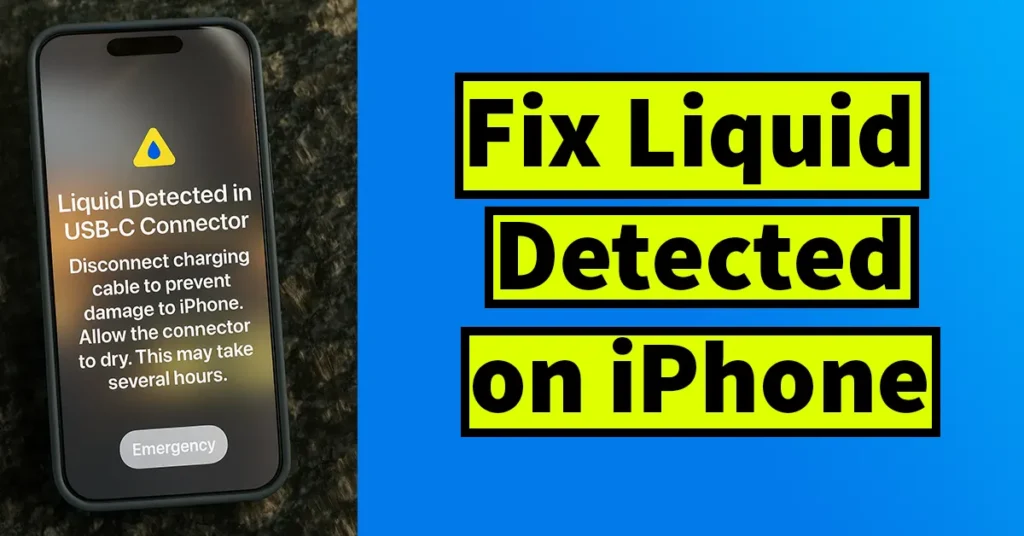Apple iPhones are known for their premium quality and high price tags. But when something goes wrong especially hardware-related issues getting it repaired through an authorized Apple service center can be equally expensive. While Apple offers a warranty for its devices, liquid damage is typically not covered under standard warranty terms. This means that even if your iPhone is still under warranty, you might have to pay out of pocket for any repairs or part replacements caused by liquid exposure.

One common and alarming issue many users encounter is a sudden warning on the screen that reads:
“Liquid Detected in USB-C Connector. Disconnect charging cable to prevent damage to iPhone. Allow the connector to dry. This may take several hours.”
This message can understandably cause panic, especially if your phone doesn’t appear to have come into contact with water. However, don’t worry this issue is often fixable at home without needing to visit a service center.
Table of Contents
When Does This Error Occur?
This warning usually appears when you connect a charger or USB-C accessory to your iPhone, and the system detects moisture or liquid in the charging port. It’s a protective feature designed to prevent short-circuiting and internal damage.
DIY Methods to Fix “Liquid Detected in USB-C Connector” Error
If you see this message, here are the steps you can take to safely resolve the issue on your own:
Immediately Disconnect the Cable
As soon as the warning appears, unplug the charging cable or USB-C accessory from your iPhone. Leaving it connected can lead to permanent damage.
Restart Your iPhone
If you’re confident that your iPhone has not come into contact with water and is in a dry environment, try restarting your device. Sometimes, this error can be triggered due to a software glitch or temporary humidity in the air.
- If the message does not appear again after restarting and reconnecting the cable, it was likely a false alarm.
- If the message reappears, continue with the next steps.
Dry the Charging Port Manually
If moisture has indeed entered the USB-C port, follow these steps:
- Turn off your iPhone to prevent any electrical issues.
- Gently wipe the USB-C port using a soft, lint-free microfiber cloth. Be careful not to insert anything deep into the port, as this may cause further damage.
- Place your iPhone upright in a dry location (preferably near a fan or with good airflow) for several hours or overnight. This allows gravity and air circulation to help the moisture evaporate naturally.
Check and Dry the Charging Cable
Sometimes, the moisture isn’t in the iPhone port but on the charging cable itself. Be sure to:
- Inspect the USB-C connector of the charging cable.
- Wipe it gently with a dry cloth and make sure it’s completely moisture-free before reconnecting it to your iPhone.
- If problem persists, Swap the charging cable, Your current one might have moisture or internal corrosion.
Avoid Using Your Phone in Humid Environments
Using your iPhone in high-humidity areas like bathrooms, saunas, or even air-conditioned rooms with condensation can trigger this error. If that’s the case:
- Move your iPhone to a drier location.
- Follow the drying steps above.
- Avoid charging your phone in such environments in the future.
Use a Water Ejection App (Optional)
To take extra precautions, you can use a third-party app such as Water Eject, available on the App Store. This app plays specific sound frequencies through your iPhone’s speakers to help expel any remaining moisture. While not a guaranteed fix, it can help in minor moisture cases, especially around the speaker grill or inside the port.
Important Safety Note: Never use a vacuum cleaner, hair dryer, or any other heating appliance to dry your iPhone. High heat or suction can cause internal damage to delicate components and make the situation worse.
While the “Liquid Detected in USB-C Connector” error can be alarming, it’s often temporary and fixable with some simple care and patience. By following the above DIY steps, you can usually resolve the issue at home and avoid costly repairs. However, if the warning persists even after trying everything, it’s best to consult an authorized Apple service center to prevent further damage.
Taking preventive measures—like avoiding high humidity zones and checking cables before use—can help ensure your iPhone stays safe and functioning at its best.
Leave a Reply